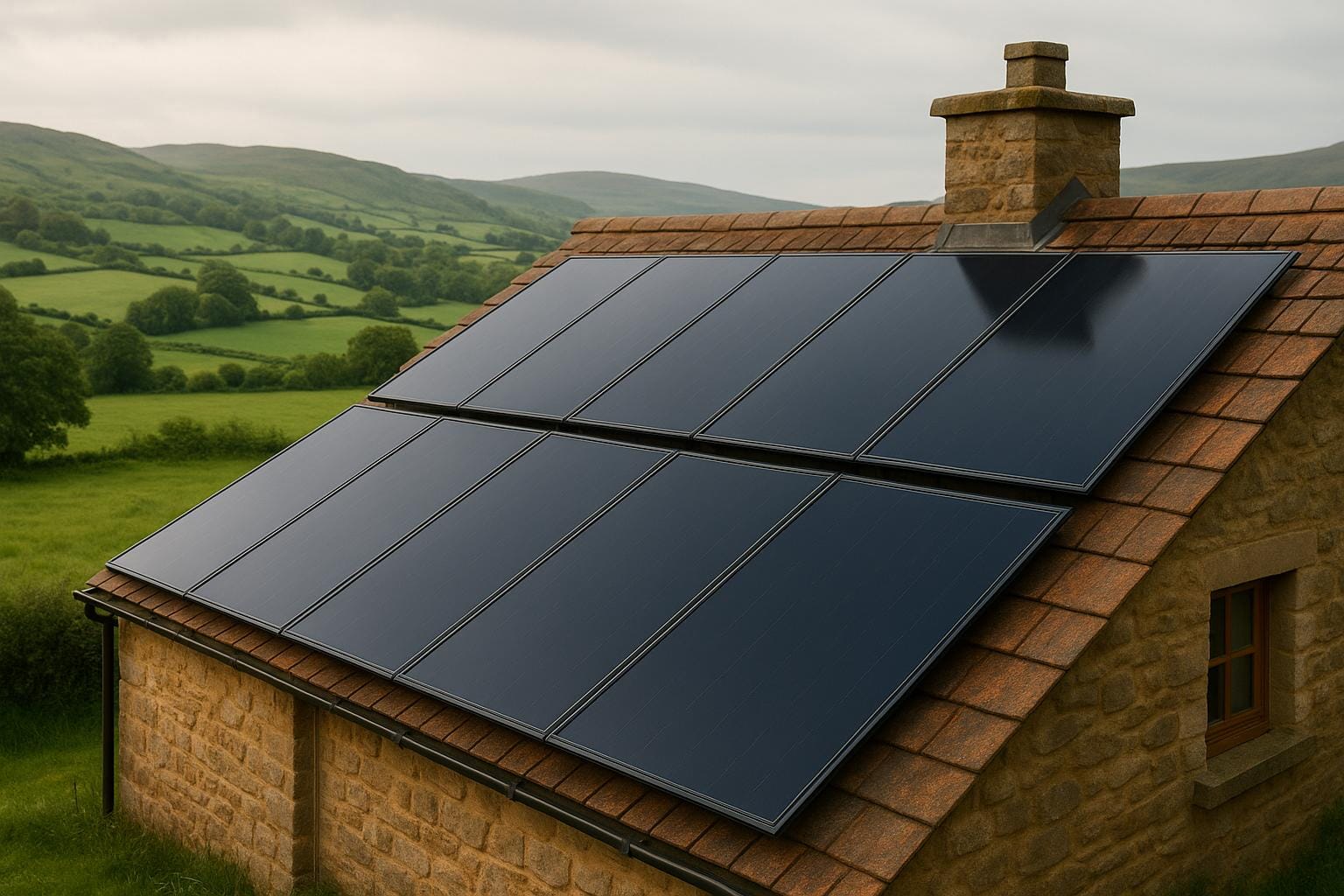CIGS Solar Panels Lifespan in Ireland
Explore the lifespan, efficiency, and performance of CIGS vs. crystalline solar panels in Ireland's unique climate conditions.

CIGS solar panels typically last 15–20 years, while standard crystalline panels (monocrystalline and polycrystalline) last longer - 20–30 years. Crystalline panels also degrade more slowly, at 0.5–0.6% per year, compared to the faster degradation of CIGS panels. However, CIGS panels perform better in low-light conditions, making them suitable for Ireland’s cloudy climate.
Key Points:
- CIGS Panels: Shorter lifespan, better in low-light, more affordable upfront, but lower efficiency (15–16%).
- Crystalline Panels: Longer lifespan, higher efficiency (~22.5%), higher upfront cost, but more durable and cost-effective over time.
Quick Comparison:
| Feature | CIGS Panels | Crystalline Panels |
|---|---|---|
| Lifespan | 15–20 years | 20–30 years |
| Efficiency | 15–16% | ~22.5% |
| Degradation Rate | ~6% per year | 0.5–0.6% per year |
| Low-Light Performance | Excellent | Good |
| Upfront Cost | Lower | Higher |
| Durability | Lower | Higher |
For Ireland’s climate, crystalline panels offer better long-term value, while CIGS panels are appealing for their low-light performance and lower upfront cost.
1. CIGS Solar Panels
Lifespan
CIGS solar panels typically last between 15 and 20 years, which is shorter than the lifespan of crystalline silicon panels. This difference is largely due to the thin-film design of CIGS panels, which makes them less durable compared to their crystalline counterparts. That said, their ability to perform well in lower light conditions makes them particularly suitable for Ireland’s often cloudy weather.
While lifespan is important, environmental conditions also play a critical role in determining how well these panels perform over time.
Durability in Irish Climate
Ireland’s weather is a mixed bag when it comes to solar panels. With mild temperatures, frequent rain, and unpredictable weather shifts, the climate can be both a challenge and an opportunity for CIGS panels. For example, temperature swings can lead to the expansion and contraction of materials, potentially causing cracks or other damage over time. Add to that the year-round cloud coverage, which exceeds 50%, and you’ve got a setting where panels must withstand constant temperature changes.
On the upside, CIGS panels are designed to handle low light conditions, which is a big plus in a country that gets just 1,100 to 1,600 hours of sunshine annually. However, Ireland’s heavy rains, strong winds, and occasional storms make expert installation essential to ensure the panels remain securely in place and maintain their performance.
Maintenance Requirements
Like most solar technologies, CIGS panels require minimal upkeep. Routine cleaning and occasional inspections are usually enough to keep them running efficiently. Ireland’s frequent rainfall often helps with natural cleaning, but stubborn debris may still require manual removal from time to time. Many CIGS panels come with warranties that can cover maintenance issues, offering some peace of mind.
Professional installation is especially important, as it ensures the panels are properly secured against Ireland’s variable weather. This step can significantly extend the lifespan of thin-film panels in such conditions.
Cost-Effectiveness
When it comes to cost, CIGS panels present a mixed picture. They are more affordable upfront compared to crystalline panels, making them an attractive option for those on a budget. However, their shorter lifespan may lead to replacement costs sooner than expected, which should be factored into long-term financial planning. With an efficiency rate of 10–13%, they also require more space to generate the same amount of electricity as higher-efficiency panels.
That said, their ability to produce energy even on cloudy days makes them a reliable choice for Ireland’s climate. Balancing factors like upfront cost, efficiency, durability, and space requirements is key to determining whether CIGS panels are the right fit for your needs.
2. Standard Crystalline Solar Panels
Lifespan
Standard crystalline solar panels typically last between 20 and 25 years, with some premium systems stretching up to 30 years. This longevity provides a solid foundation for assessing their performance under Ireland's unique weather conditions.
When it comes to degradation, crystalline panels follow a well-established pattern. Most conventional crystalline silicon panels degrade at a median rate of 0.5–0.6% per year, while the average sits slightly higher at 0.8–0.9% per year. To put it simply, after two decades, these panels can still generate about 80–85% of their original output.
Durability in Irish Climate
One of the standout features of crystalline panels is their ability to maintain steady performance even in low-light conditions, making them particularly suitable for Ireland, where annual sunshine hours range from 1,100 to 1,300.
Even on overcast or rainy days - which are quite common in Ireland - these panels continue generating electricity. Under cloudy skies, photovoltaic (PV) panels typically produce 10–25% of their maximum capacity. As James Fenton, director of the Florida Solar Energy Center, puts it:
"The panel is always working. The question is how much electricity comes out of it based on the amount of light."
However, mono-crystalline panels do have a drawback: their series string structure can cause performance issues if parts of the panel are covered by snow or dirt. This makes proper positioning and regular cleaning especially important in Ireland’s unpredictable weather.
Compared to CIGS panels, which are optimized for low-light efficiency, crystalline panels provide a more consistent output across different conditions. This makes them a solid choice for Irish homeowners looking for reliability in their solar energy systems.
Maintenance Requirements
Crystalline panels require minimal but essential maintenance to keep running efficiently. Regular cleaning and annual inspections are key to ensuring they perform at their best.
In Ireland, annual maintenance costs typically fall between $120 and $360. Professional cleaning services range from $36 to $72 per visit (usually twice a year), while annual system inspections cost about $120 to $180. Neglecting maintenance can lead to a significant drop in efficiency - dust buildup alone can reduce output by up to 30% per month.
Another important factor to consider is inverter replacement, as inverters generally need to be replaced every 10 years. Replacement costs range from $1,200 to $2,400, so it’s wise to include this in long-term budgeting.
| Maintenance Aspect | Annual Cost (USD) | Details |
|---|---|---|
| Professional Cleaning | $72–$144 | 2 visits per year at $36–$72 each |
| Annual Inspection | $120–$180 | Comprehensive system check |
| General Maintenance | $120–$360 | Total yearly maintenance expenses |
| Inverter Replacement | $120–$240/year | Amortized over a 10-year lifespan |
Cost-Effectiveness
While crystalline panels often come with higher upfront costs compared to CIGS panels, their longer lifespan and predictable degradation rates make them a more economical choice in the long run.
Proper installation is especially important for these panels, given the need for precise positioning to optimize performance. When investing in crystalline panels, it’s crucial to choose manufacturers offering comprehensive warranties that cover both the product and its performance.
With their durability, consistent output, and manageable maintenance requirements, crystalline panels remain a dependable, long-term solution for Irish homeowners seeking to harness solar energy effectively.
I DARE You to Compare! CIGS vs. Rigid Solar Panel - ULTIMATE TEST!
Advantages and Disadvantages
When choosing between CIGS and crystalline solar panels for installations in Ireland, understanding their strengths and weaknesses within the context of Ireland's often overcast and variable climate is essential. Below is a breakdown of the key factors to consider, building on earlier discussions about lifespan, durability, and maintenance.
CIGS Solar Panel Advantages
Superior Low-Light Performance
CIGS panels excel in low-light conditions, delivering nearly double the efficiency of crystalline panels under partial shading. This makes them a strong choice for Ireland, where cloudy skies are common.
Better Temperature Tolerance
CIGS panels are less affected by temperature increases. While crystalline panels lose about 0.6% of their output per °C rise, CIGS panels only drop by around 0.3% per °C. This smaller decline helps maintain energy production during warmer periods.
Flexible Installation Options
Thanks to their lightweight and flexible design, CIGS panels are ideal for installations on surfaces with weight limitations or non-standard shapes.
CIGS Solar Panel Disadvantages
Lower Efficiency
CIGS panels generally have an efficiency of 15–16%, falling short of the 22.5% typical for crystalline panels. This means they require more roof space to generate the same amount of power, which could be a limiting factor for some installations.
Faster Degradation
These panels degrade at a rate of about 6% per year, significantly higher than the 0.5–0.6% annual degradation seen in crystalline panels. This faster decline impacts both their lifespan and long-term cost-effectiveness.
Higher Maintenance Demands
Due to their lower durability, CIGS panels need more frequent inspections and upkeep.
Crystalline Solar Panel Advantages
Exceptional Durability
Crystalline panels are known for their long-lasting performance. Their durability, combined with warranties of 20–25 years, ensures consistent energy output and reliability over time.
Higher Energy Density
With the ability to produce more electricity per square foot, crystalline panels are ideal for installations where roof space is limited.
Crystalline Solar Panel Disadvantages
Prone to Physical Damage
The rigid wafer structure of crystalline panels makes them susceptible to microcracks, which can reduce efficiency and potentially create safety issues. This is especially concerning in installations exposed to physical stress or extreme weather.
Reduced Performance in Shaded Areas
Crystalline panels are less efficient under partial shading. Their series string configuration means that shading on even a small section can significantly reduce overall output, requiring careful placement and regular cleaning.
Higher Sensitivity to Temperature
Crystalline panels lose efficiency faster as temperatures rise, though Ireland's moderate climate helps mitigate this issue to some extent.
| Feature | CIGS Solar Panels | Crystalline Solar Panels |
|---|---|---|
| Efficiency Rate | 15–16% | ~22.5% |
| Degradation Rate | ~6% per year | ~0.5–0.6% per year |
| Temperature Coefficient | 0.3% per °C | 0.6% per °C |
| Low-Light Performance | Excellent; nearly double crystalline efficiency | Good, though output drops in shaded conditions |
| Space Requirements | Requires more space | Requires less space |
| Durability | Lower durability | Higher durability, backed by 20–25 year warranties |
| Installation Flexibility | High; lightweight and flexible design | Limited by rigid mounting requirements |
| Maintenance Needs | Higher due to lower durability | Lower, though periodic crack monitoring is advised |
Conclusion
Crystalline solar panels stand out as a reliable and long-lasting choice for solar installations in Ireland. When it comes to lifespan, they clearly outperform thin-film options like CIGS panels, which typically last between 10–20 years. In contrast, monocrystalline panels can operate for 25–40 years, while polycrystalline panels offer a solid 20–35 years of service. This extended lifespan, paired with a lower degradation rate, ensures consistent energy output and reduces the need for replacements or frequent maintenance.
Beyond their durability, crystalline panels excel in efficiency, making them ideal for installations with limited roof space. Their ability to generate more energy per square foot is a significant advantage, especially in Ireland’s unpredictable weather conditions. For commercial setups, the combination of reliable long-term performance and strong manufacturer warranties provides peace of mind and protects financial investments.
Thanks to their robust construction, crystalline panels also require less frequent maintenance. While CIGS panels might appeal to those seeking lower upfront costs, their shorter lifespan and higher maintenance needs can quickly diminish any initial savings. For most Irish homeowners and businesses, choosing high-quality crystalline panels installed by experienced professionals offers the best balance of performance, durability, and long-term financial benefits.
FAQs
How do CIGS solar panels perform compared to crystalline panels in Ireland’s cloudy weather?
CIGS (Copper Indium Gallium Selenide) solar panels are known for their ability to outperform crystalline panels in cloudy conditions, making them particularly well-suited for Ireland's frequently overcast skies. These panels are specifically designed to efficiently convert diffused sunlight into electricity, giving them a noticeable advantage in low-light situations.
Both CIGS and crystalline panels generally have a lifespan exceeding 20 years. However, factors like humidity and temperature fluctuations can impact their durability over time. To make sure your solar panels deliver consistent performance and reach their full lifespan, regular maintenance is essential.
What should I consider when choosing between CIGS and crystalline solar panels for my home in Ireland?
When deciding between CIGS (Copper Indium Gallium Selenide) and crystalline solar panels for your home in Ireland, it’s worth comparing their advantages and drawbacks to see which fits your needs better.
CIGS panels are known for being lightweight and flexible, making them ideal for roofs with unusual shapes or materials. They also handle shaded areas well and are less likely to develop microcracks, which can extend their durability. However, their efficiency is generally lower than that of crystalline panels, so you might need more roof space to generate the same amount of energy.
Crystalline panels, by contrast, are more efficient and typically last longer - around 25 to 30 years. They’re a great choice if you're working with limited roof space and want to maximize energy production. That said, they may be more susceptible to damage during Ireland’s challenging weather conditions. To make the right choice, think about your energy needs, roof design, and budget.
What are the long-term costs of using CIGS solar panels compared to crystalline panels in Ireland?
The long-term expenses of using CIGS (Copper Indium Gallium Selenide) solar panels versus crystalline panels in Ireland hinge on factors like upfront costs, efficiency, and durability. CIGS panels are often cheaper to manufacture, which can make them a more budget-friendly option at the start. However, their lower efficiency means you might need to install more panels to produce the same amount of electricity, which could drive up installation costs.
Both CIGS and crystalline panels typically have a lifespan of 25–30 years, but CIGS panels may degrade more quickly due to the nature of their materials. This could mean additional costs for replacements or maintenance down the line. So, while CIGS panels might save you money initially, their lower efficiency and faster degradation could lead to higher overall costs over time.

